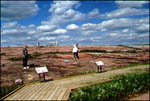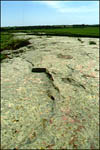By Dan Olson
May 28, 1999
|
|
RealAudio 3.0 |
 |
|
| Unique rock carvings attract thousands of
visitors, archaelogists, and students.
|
Tucked away in a small patch of southwestern Minnesota prairie is one of the state's enduring mysteries. Centuries ago people carved thousands of symbols into rocks near the small town of Jeffers. Who were they, and why did they painstakingly carve petroglyphs of animals and other figures? This summer archeologists will take another crack at answering the questions. But in the meantime, the site is becoming a hot spot for visitors interested in the carvings.
THREE HOURS WEST AND SOUTH of the Twin Cities, there's an 80-acre patch of restored prairie called the Jeffers Petroglyph Site. There, a 300-yard-long crescent of red quartzite slices through the sod. The broad, flat rock sits at a low angle facing southwest. A nearly constant wind rustles the tall grass and rattles microphones at the rock's border. Rain from low clouds dots the blue denim jacket of Micheal Lucio as he walks on the crushed rock path to the petroglyphs.
Lucio: These rock art out here were really written by our ancestors. This is such a beautiful and significant place out here that it really does have a lot of meaning to our people.Lucio is a Jeffers Site interpreter for the Minnesota Historical Society. He and other Dakota members of the Lower Sioux Agency say the carvings of turtles, snakes, bison, and other figures show the place was used by their ancestors thousands of years ago - not just to rest, but also to meditate.
Lucio: Many of these carvings interpret man, animals, hunting. Many of the people who traveled through here wanted to interpret the meaning of what life had to offer them.Ruby Winters Bennett and other descendants of white settlers in the area have known about the site all their lives. The remote location, away from town lights and prying eyes, inspired romance.
Winters: Yes, my husband and I came up here and dated.For decades, visitors have come to the spot to admire the view and puzzle over the rock carvings.
Winters: And it was interesting to view. We didn't know what it meant.
 |
|
| This carving of a hand holds great
significance in Dakota mythology. |
Many of the more than 2,000 petroglyphs, what archaeologists call rock art, at the Jeffers site appear to tell a story. The bison carvings may be a wish for a successful hunt, or the recounting of one. The turtle in the religion of the Dakota is a messenger between humans and spirits. The carving of a hand, again according to Dakota beliefs, marks where a human with extraordinary powers climbed out of the rock and closed the opening after receiving guidance from the spirits inside. The mystery of one of petroglyphs has been solved. Site manager Tom Sanders says several carvings show a shaft with a square object near one end.
Sanders: I don't know if you can hear or pick this up . . . can ya hear that? Now that's an atlatl without a banner stone.
Sanders swings an atlatl, a shaft of wood with a notch at the end. As long as 20,000 years ago hunters used the launching device as an extension of their arm to add power and distance to spears and darts. But the "whiff" made too much noise and scared off animals, Sanders says, until hunters discovered that adding a square-shaped stone to the atlatl shaft cuts the noise.
Sanders: Now we'll do one with a banner stone (silence) can you hear the difference? That's enough noise for a buffalo or an elk or dear to hear that to hear and move and out of the way.
 |
|
| The long rock outcropping is surrounded by
verdant prairie grass. |
Sanders: The quartzite is polished on this edge so much you can actually see your face, you can see your reflection, see my finger; it's like a mirror - for 9,000 years buffalo have been rubbing their winter hair off in the spring, polishing this stone.Abundant game and fresh water from the nearby Little Cottonwood River attracted prehistoric visitors to the Jeffers site. But there are lots of rock outcroppings in the area where food and water were plentiful, yet there are no carvings on them. Why did early people return season after season to the Jeffers Site and spend so much time making the carvings?. Micheal Lucio says for him it's because the site's beauty helps visitors regain balance in their lives.
Lucio: Time kinda stands still. You know. Time kinda stands still here. And you're able to hear the birds, the winged ones, and understand how life is so beautiful and when I leave here, which I will, and go back home I'll just grab my wife and hug her and kiss her, and wait for my kids to come home and hug them and kiss them and be thankful, be thankful.
Photos courtesy of the Minnesota Historical Society
and Jens Gunelson.
